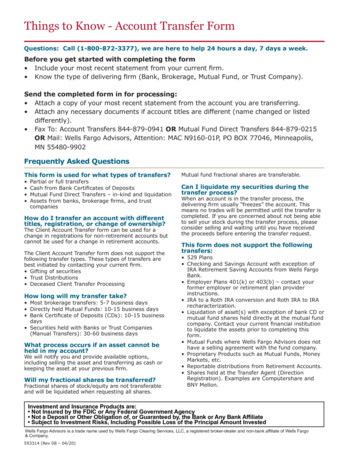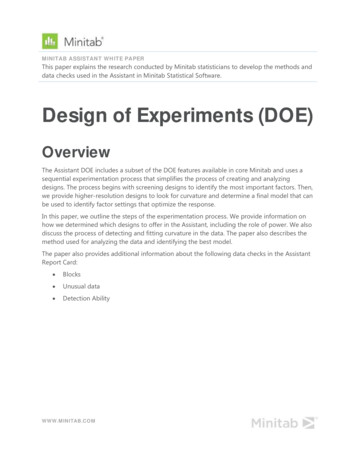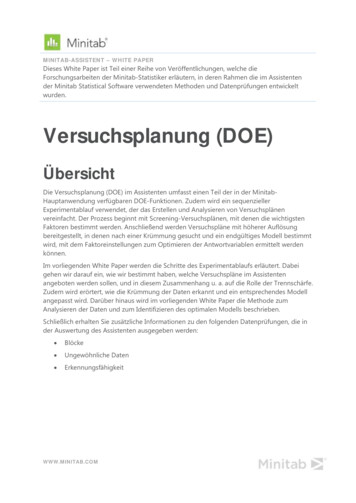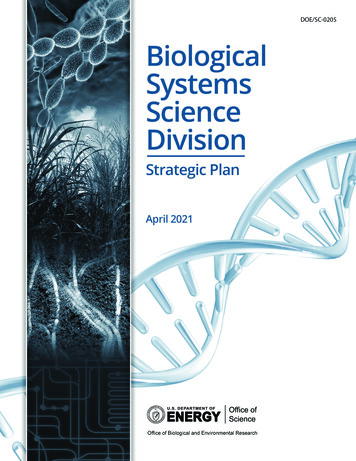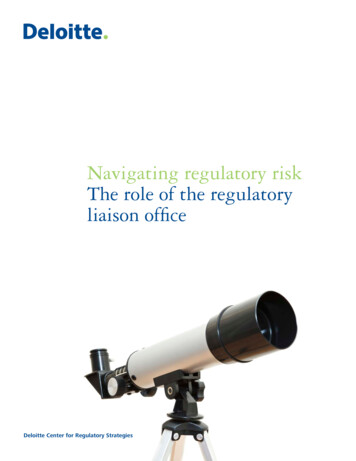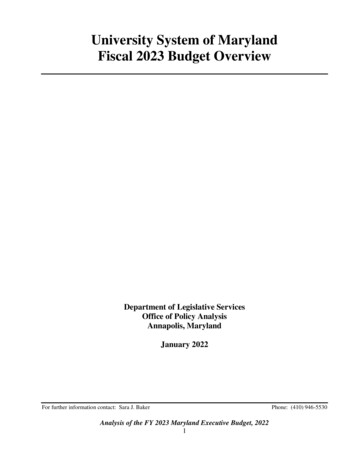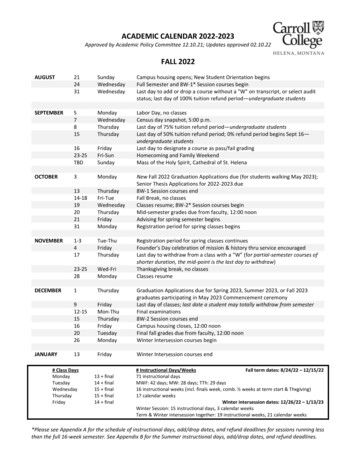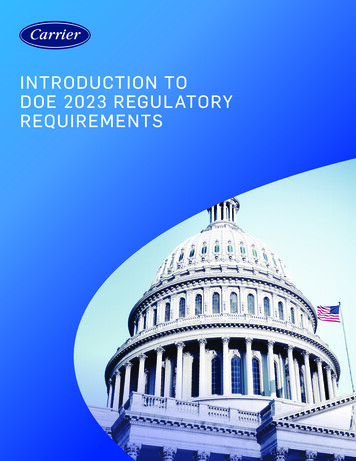
Transcription
INTRODUCTION TODOE 2023 REGULATORYREQUIREMENTS
Industry-first EcoBlue TechnologyINNOVATIVE FEATURESWith EcoBlue Technology, we’ve put a whole new spinon fan systems, replacing belt drive designs with anall-new vane axial indoor fan. This exclusive innovativetechnology delivers a simpler, more compact designthat you have to see to believe.Features like a direct-drive ECM motor enables greater efficiency in airflow systems while a dynamically balanced blade fanprovides reliable performance. Plus, a simplified design helps lower installation and maintenance costs.Even more impressive than everything that went into our new Weather Series Rooftops* with EcoBlue Technology is everythingthat came out.75% fewermoving partsIntuitive fanspeed adjustmentcontrolsORIGINAL DESIGN AND FITWe’ve revolutionized the rooftop categoryby making a number of innovative changesto our Weather Series Units.* But one thingthat’s just as important is what we didn’tchange. In terms of footprint, we built on anoriginal, using the same Carrier unit designthat’s been trusted for years. This makes forhassle-free replacement of existing units andkeeps installation costs down.Up to 40% moreenergy efficientNo shaft orshaft bearingsSame EfficientUnit DesignCONTENTS:LowinstallationcostsEFFICIENCY ACROSS MODELSWeather Series Units * are available inmultiple efficiency levels, so you canchoose the right option available forvarying customer needs and budgets.While efficiency ratings vary, WeatherSeries Units * are up to 40 percent moreenergy efficient than models built 17years ago – ensuring lower operating costsregardless of the selected unit.No belts orpulleysOriginalfit forhassle-freereplacement*Select models. Ask your local Carrier expert or visit Carrier.com/ecoblue for details.2Introduction3Carrier Readiness4Commercial Rooftop Unit Rating Comparisons5Commercial Split System Rating Comparisons6New Technologies7New Refrigerant for LocalRooftop UnitsinventoryWhere to Go for immediatelyMore InformationavailableNotes91011
Dear Carrier Expert:We are getting ready for the 2023 regulatory requirementsand we want you to be ready too!On January 1, 2023, the Department of Energy’s (DOE) new minimum efficiency standards for commercialpackaged air conditioners (ACs) and heat pumps (HPs) will go into effect. These new regulations are part ofthe DOE’s ongoing initiative to reduce overall energy consumption in the United States. These changes willpresent new complexities, but Carrier is prepared, and we are here to support you through this transition.HVAC manufacturers will be required to comply with a new testing procedure for developing efficiencyratings. Carrier is committed to leading our industry in compliance and we have developed thiscomprehensive launch kit to help you fully understand and be prepared for these changes.The 2023 Regulatory Launch Kit provides information to help you get up to speed with the new requirements,including: Minimum efficiency changes Regulatory-ready product updates New technologiesWe are all in this together. As your trusted manufacturer, we will continue to make resources available toyou leading up to January 1, 2023. Be sure to visit Carrier’s 2023 Regulatory Launch Kit site on HVACpartnersfor the most current marketing resources.Thank you for your support!3
CARRIER READINESSTIME FOR A NEW CHANGEAs the innovative leader in building comfort and the inventor of modern air conditioning, Carrier has thrived bycontinuously looking for the next advancement in comfort technology. That’s why we are always prepared whenit’s time to meet new, federally mandated minimum efficiency standards.*Why the ChangeEvery six years the Department of Energy (DOE) reanalyzes the effects of energy usage,sets minimum efficiency requirements and manages the testing standards by which thoseefficiencies are measured. In 2018 the DOE started the first phase of their six-year planrequiring a 13% increase in energy efficiency for commercial packaged air conditioners,heat pumps and split systems. The second phase of this plan will start in 2023.2023 Commercial Minimum Efficiency Change – IEER, COPStarting on January 1, 2023 all commercial air conditioning and heat pump equipment from 65,000 btu/h to 760,000 btu/h willrequire and additional 15% efficiency increase from the existing ratings set in 2018. Combined with the efficiency requirementsimplemented in 2018 this will result in a 30% increase over the six-year period.Additionally, all gas fired commercial air conditioners will be required to meet an 81% gas efficiency ratingIn 2023, there will not be any changes to the testing procedures mandated for commercial air conditioners and heat pumpsgreat than 65,000 btu/h.2023 Single Phase Commercial – SEER2, EER2 and HSPF2The DOE has also reanalyzed and adjusted the minimum efficiencies of single-phase air conditioners and heat pumps, 5 tonsor less. Single phase and residential products will also be required to comply with a new testing procedure for developingefficiency ratings. Compared to today’s test procedure, the external static pressure used when testing will be increased byup to 5X to better reflect field conditions.Since the new testing requirements are more stringent and reduce the resulting efficiency rating, in 2023, there will be newmetrics and nomenclature – SEER2, EER2 and HSPF2. On the same system, compared to SEER ratings, the new SEER2ratings will be lower and the minimum efficiencies will be reduced to account for the more difficult test procedure.DOE Enforcement for the ManufactureAfter January 1, 2023, Carrier will no longer manufacture any rooftop units that are not compliant with the new DOE energyefficiency mandates. According to 10CFR part 431.97, compliance is only on the date of manufacture – this means anythree-phase product produced on 12/31/2022 or earlier is still able to be sold after the compliance date.Please refer to the residential DOE 2023 regulatory brochure for more details on single phase requirements and enforcement.*www.energy.gov4
COMMERCIAL ROOFTOP UNIT RATING COMPARISONSCOMMERCIAL PACKAGED AIR CONDITIONER AND HEAT PUMP RATINGSThe new 2023 minimum efficiency standards for packaged air commercial air conditioners and heat pumps willincrease the minimum efficiency by 15% over the January 1, 2018 efficiency standards. This second phase ofregulatory increases will bring the total efficiency of these air conditioning system up by 30% from 2015.Packaged Air Conditioning Units – Air Cooled Direct ExpansionEquipment TypeExisting January 1, 2018 New January 1, 2023Small Commercial Packaged AC’s( 65,000 Btu/h 135,000 HeatingHeating12.9 IEER14.8 IEERAll Other Types of Heating12.7 IEER14.6 IEERLarge Commercial Packaged AC’s( 135,000 Btu/h 240,000 HeatingHeating12.4 IEER14.2 IEERAll Other Types of Heating12.2 IEER14.0 tingElectric11.6 IEER13.2 IEERAll Other Types of Heating11.4 IEER13.0 IEERVery Large Commercial Packaged AC’s( 240,000 Btu/h 760,000 Btu/h)Packaged Air Conditioning Units – Air Cooled Heat PumpsEquipment TypeSmall Commercial Packaged AC’s( 65,000 Btu/h 135,000 Btu/h)Large Commercial Packaged AC’s( 135,000 Btu/h 240,000 Btu/h)Very Large Commercial PackagedAC’s( 240,000 Btu/h 760,000Btu/h)Existing January 1, 2018 New January 1, 2023Electric Resistance or No Heating12.2 IEER, 3.3 COP14.1 IEER, 3.4 COPAll Other Types of Heating12.0 IEER, 3.3 COP13.9 IEER, 3.4 COPElectric Resistance or No Heating11.6 IEER, 3.2 COP13.5 IEER, 3.3 COPAll Other Types of Heating11.4 IEER, 3.2 COP13.3 IEER, 3.3 COPElectric Resistance or No Heating10.6 IEERNA3 to 5 Tons Packaged Air Conditioning Units – Air Cooled DX and Heat PumpsEquipment TypeSmall Commercial Packaged AC’s( 65,000 Btu/h)All Heat TypesThree Phase*Single Phase14 SEER, 8.0 HSPF13.4 SEER2, 6.7 HSPF2*Three phase 3-5 ton models have the same efficiency as existing models today. There is no change for SEER or HSPF for three phase models, only single phase ismoving to SEER2 and HSPF2. Please refer to the residential DOE 2023 regulatory brochure for more details on SEER2 and HSPF2.5
COMMERCIAL SPLIT SYSTEM RATING COMPARISONSCOMMERCIAL SPLIT AIR CONDITIONER AND HEAT PUMP RATINGSThe new 2023 minimum efficiency standards for split air commercial air conditioners and heat pumps willincrease the minimum efficiency by 15% over the January 1, 2018 efficiency standards. This second phase ofregulatory increases will bring the total efficiency of these air conditioning system up by 30% from 2015.Commercial Split Air Conditioning Units – Air Cooled Direct ExpansionEquipment TypeExisting January 1, 2018New January 1, 2023Small Commercial Split AC’s( 65,000 Btu/h 135,000 HeatingHeating12.9 IEER14.8 IEERAll Other Types of Heating12.7 IEER14.6 IEERLarge Commercial Split AC’s( 135,000 Btu/h 240,000 eatingElectric12.4 IEER14.2 IEERAll Other Types of Heating12.2 IEER14.0 atingHeating11.6 IEER13.2 IEER11.4 IEER13.0 IEERVery Large Commercial Split AC’s( 240,000 Btu/h 760,000000 Btu/h)All Other Types of HeatingCommercial Split Air Conditioning Units – Air Cooled Heat PumpsEquipment TypeExisting January 1, 2018New January 1, 2023Small Commercial Split AC’s( 65,000 Btu/h 135,000 HeatingHeating12.2 IEER, 3.3 COP14.1 IEER, 3.4 COPAll Other Types of Heating12.0 IEER, 3.3 COP13.9 IEER, 3.4 COPLarge Commercial Split AC’s( 135,000 Btu/h 240,000 eatingElectric11.6 IEER, 3.2 COP13.5 IEER, 3.3 COPAll Other Types of Heating11.4 IEER, 3.2 COP13.3 IEER, 3.3 COP10.6 IEER, 3.2 COP12.5 IEER, 3.2 COP10.4 IEER, 3.2 COP12.3 IEER, 3.2 ingVery Large Commercial Split AC’s Electric( 240,000 Btu/h 760,000000 Btu/h)All Other Types of HeatingWhat It All MeansBreaking down the numbers, the 2023 efficiency standards represent a 15% energy efficiency increase from currentstandards, across the board. Many of our current products already meet or exceed the minimum efficiency standardsset for 2023. We have been working for several years in anticipation of these changes and are ready to increase theefficiency of our remaining product lines before the new standards take effect on January 1, 2023.6
NEW TECHNOLOGIESECOBLUE TECHNOLOGYTMAs we continue to look for measured improvements in the energy efficiency and performance of our heating and cooling systemsleading up to 2023, we continue to expand our EcoBlue technology across our product lines.Currently the EcoBlue direct drive vane axial fan systems with EC motors only exist on our 3–6 ton, small rooftop units. Thistechnology will soon be available on all small and medium light commercial rooftop units up to 27.5 tons. EcoBlue Technologyhas been designed to improve performance and efficiency while decreasing maintenance and installation costs.Most notable of EcoBlue Technology’s many features is the exclusive beltlessdirect-drive vane axial fan system an industry first for rooftop units. Thispatent-pending technology replaces traditional belts and pulleys with asimpler, more compact design, all with 75 percent fewer moving parts. Theoutdoor fan system’s high-density composite blade fan is also an exclusivedesign. Other technological advances that differentiate these units include: anew control board and coil technology, increased factory options and a tool-lessfilter access door. Units with EcoBlue Technologyare up to 60 percent more efficientthan RTUs of 17 years ago, and40% more efficient than traditionalforward curve fans today. Thisensures lower operating costswhile increasing the opportunityfor utility rebates. 75% fewer moving partscompared to traditional fans.No fan belts, pullies, shaftsand bearings. Maintaining our historicalfootprints while increasingenergy efficiency, allows forfaster, easier, and less costlyreplacement opportunities In addition, optional SystemVucontrols bring the benefits ofsmarter diagnostics by providingongoing, real-time informationto help ensure the efficientoperation and optimumperformance of the unit.Split System with EcoBlue FansCarrier is expanding the use of the highly efficient EcoBlue direct drive fan system into the Commercial SplitSystem market. All 6 to 10 ton split system air handlers will soon be available with direct drive van axialfans. All of the same efficiencies and convenience of the EcoBlue fan system apply to the 40RU product line.Multistage – Single Circuit DesignCarrier rooftop units will continue to utilize a single circuit Multistage compression system across our product lines that is designedto increase energy efficiency and heat transfer rates across the condenser coil. Using the full surface of the condenser coil throughoutfull load or part load conditions allows our units to achieve greater cooling efficiencies without the need to increase the footprint ofthe unit.7
NEW TECHNOLOGIESThermal Expansion Valves - TXVsThe use of Thermal Expansion Valves will take over for the older style fixed orificemetering devices in our light commercial 6 to 27.5 tons rooftop units. A TXV is capableof operating more efficiently at part load conditions compared to a fixed orifice systemdue to its ability to precisely control the rate of refrigerant flow based on thetemperatures and load of the system.While a fixed orifice metering device will always deliver a fixed amount of refrigerantregardless of system load, a smart system using a TXV can avoid operating withimproper refrigerant levels and reduce the amount of resulting temperature swings.TXV’s will not only greatly impact energy efficiency of the system but also increasethe durability of the refrigeration system as well as occupant comfort.SystemVuTMCarrier rooftop units will continue to offer the SystemVu controller,which is designed to enhance energy efficiency and occupantcomfort control. The controller’s capability to utilize advancedsequences and staging techniques ensure the connected systemsare operating at their most efficient point and making the most ofpart load hours. SystemVu also provides superior reliability anddiagnostic capabilities including historical.The SystemVu controller’s intuitive display menu allows quickand easy access to more than 300 possible configuration pointsand more than 300 status, troubleshooting, diagnostic andmaintenance points. A USB port makes data exchanging easyand accurate, further enhancing one of the most efficientpackaged rooftop product lines.Energy RecoveryAnother exciting product that will be used to boost energy efficiency is the EnergyX integrated factory installed energy recoverysystem. This system provides a greater degree of operational and application flexibility while providing high system efficienciesand enhanced operational control, all with a packaged rooftop unit. This energy recovery system will not only boost energy efficiencybut provide extra cooling capacity, dehumidification, heating capacity and can even allow the entire system to be downsized.WheelRotation8
NEW REFRIGERANT FOR ROOFTOP UNITS A New Refrigerant for a New StandardIn a worldwide effort to address climate change concerns, global leaders have proposed a phase down of high Global WarmingPotential (GWP) refrigerants as a part of the Kigali Amendment to the United Nations’ Montreal Protocol. Although the UnitedStates as a whole has not yet ratified this agreement, states involved in the U.S. Climate Alliance* are embracing the reductions.Based on proposed California regulations, it is anticipated that many U.S. states will be limiting the GWP for refrigerants used inHVAC applications at a maximum of 750, possibly as early as 2025.Our current Puron refrigerant, while excellent at providing a non-ozone-depleting alternative to R-22, has a GWP of 2088, wellabove the anticipated future limit. That is why we are in the process of developing new products that will use Puron AdvanceTMrefrigerant. The new Puron Advance is composed of R-454B, a blend of R-32 and R-1234yf. It has a much lower GWP — 465 —which easily surpasses the proposed 2025 requirement. And, it will continue to meet the anticipated future Kigali phase downrequirements well into the 2030s.Puron Advance falls into a new classification on the AmericanPuron Advance falls into a new classification on the American SocietySociety of Heating, Refrigerating and Air-Conditioning Engineersof Heating, Refrigerating and Air-Conditioning Engineers (ASHRAE)(ASHRAE) Standard 34 flammability and toxicity matrix – A2L.Standard 34 flammability and toxicity matrix — A2L. A2L refrigerantsA2L refrigerants are classified by ASHRAE as having lowerare classified by ASHRAE as having lower toxicity and lower flammability.toxicity and lower flammability. Our current Puron refrigerant,Our currentPuron refrigerant,falls intothe A1 categoryforignitionR-410A,falls into theR-410A,A1 categoryfor refrigerantswith norefrigerantswithnoignitionatorbelow60 C.Andwhilethatmakesat or below 60 C. And while that makes A2Ls more flammableA2Ls morethanflammablethansuchtheyas R-410A,arestillflammablemuchA1s, suchasA1s,R-410A,are stilltheymuchlessless an natural gas or propane. According to AHRI researchresearch emainslow.low.Here’sHere’swhy:why: A2Ls,like PuronAdvance,hardto ignite(theyignitionrequireA2Ls, like PuronAdvance,are hardto igniteare(theyrequiresignificantenergy) so theywill not beignited energy)by static soelectricitysignificantignitionthey will not be ignited bystatic electricity or a water heater pilot A significant leak of an A2L, such as Puron Advance, would be A significant leak of an A2L, such as Puron Advance, wouldrequired to reach a flammable concentration of 11.8% lower flamebe required to reach a flammable concentration of 11.8%limit (LFL)lower flame limit (LFL) ConcentrationsA2Ls,Advance,like PuronAdvance,below Concentrationsof A2Ls, likeofPuronbelowthe LFLwill theonlyLFLwill onlythroughburn whilepassingflameandandwill notburn while passinga flameandthroughwill not aignitesustainignite and sustain a flamea flameASHRAE Standard 34 Safety rideA2LB2LAmmonia No FlamePropagationat 60 CA1Increasing Flammabilitythe Big Difference?What’s What’sthe BigDifference?B1SulfurDioxideLower ToxicityHigher Toxicity If an unlikely ignition does occur, the resulting energy is veryor greater)400 ppm) If an unlikelylowignitionoccur,the resultingis verywithwith adoesburningvelocityof aboutenergy2.0 inchesperlowsecondIncreasing Toxicitya burning velocity of about 2.0 inches per secondAs an added precaution, Carrier will add safety features in allAs an addedprecaution,Carrierwill addsafetywhichfeaturesin includeall systemssystemscontainingPuronAdvancecouldleak containing Puron Advance which could include leak detectionsensors andmitigationprocedures.detectionsensorsand mitigation procedures.(OEL of 400 ppm(OEL of less thanThe change to Puron Advance is just that — a change. But since it will meet regulatory requirements far into the future, it should bea change thatlastsForwardquite a while.we moveforward with implementing Puron Advance, Carrier will support you all along the wayMovingwith AsPuronAdvancemaking the transition as smooth as possible.As a leader in the HVAC industry, Carrier has been working towards creating a more GWP-friendly refrigerant since before2010. As we move forward with implementing Puron Advance, we will support you all along the way. Over the next fouryears, AHRI and Carrier will continue leading the effort to finalize guidelines on handling, transporting and storing the newrefrigerant. We will keep you up to date as details become available.Thank you for your continued confidence in Carrier products. We look forward to working with you in making the transitionto Puron Advance as smooth as possible!9
WHERE TO GO FOR MORE INFORMATIONMake the CommitmentRemember, we ALL have a stake in this. As your trusted supplier, we will invest the time andresources to make compliance as easy as possible. That includes training, updated productlabeling, and continued communications about this topic.In the end, we encourage you to make the commitment as well. Start preparing now by gettingup to speed on the upcoming 2023 regulations and taking advantage of your resources. If youhave any questions regarding the new 2023 regulations, reach out to your local distributor.HVAC PartnersVisit HVACpartners.com for access to the 2023 Regulatory Launch Kit page. Visit often, as we willbe adding new product information and regulatory details to the site as they become available.Go to: HVACpartners Marketing Tools Sales Tools Marketing Launch Kits 2023 RegulatoryContent includes: 2023 Readiness Flyer 2023 Regulatory Resource Guide 2023 Regulatory Readiness Sales PPTOther Resources U.S. Department of Energy – www.energy.gov U.S. Environmental Protection Agency – www.epa.gov EPA and DOE Energy Efficiency – www.energystar.gov U.S. Government’s national archives – www.federalregister.gov10
NOTES11
2022 Carrier. All Rights nufacturer reserves the right to discontinue, or change at any time, specifications or designs without notice or without incurring obligations.All trademarks and service marks referred herein are property of their respective owners.Cat No. 04-811-90044
efficiencies are measured. In 2018 the DOE started the first phase of their six-year plan requiring a 13% increase in energy efficiency for commercial packaged air conditioners, heat pumps and split systems. The second phase of this plan will start in 2023. TIME FOR A NEW CHANGE Why the Change 2023 Commercial Minimum Efficiency Change - IEER, COP
